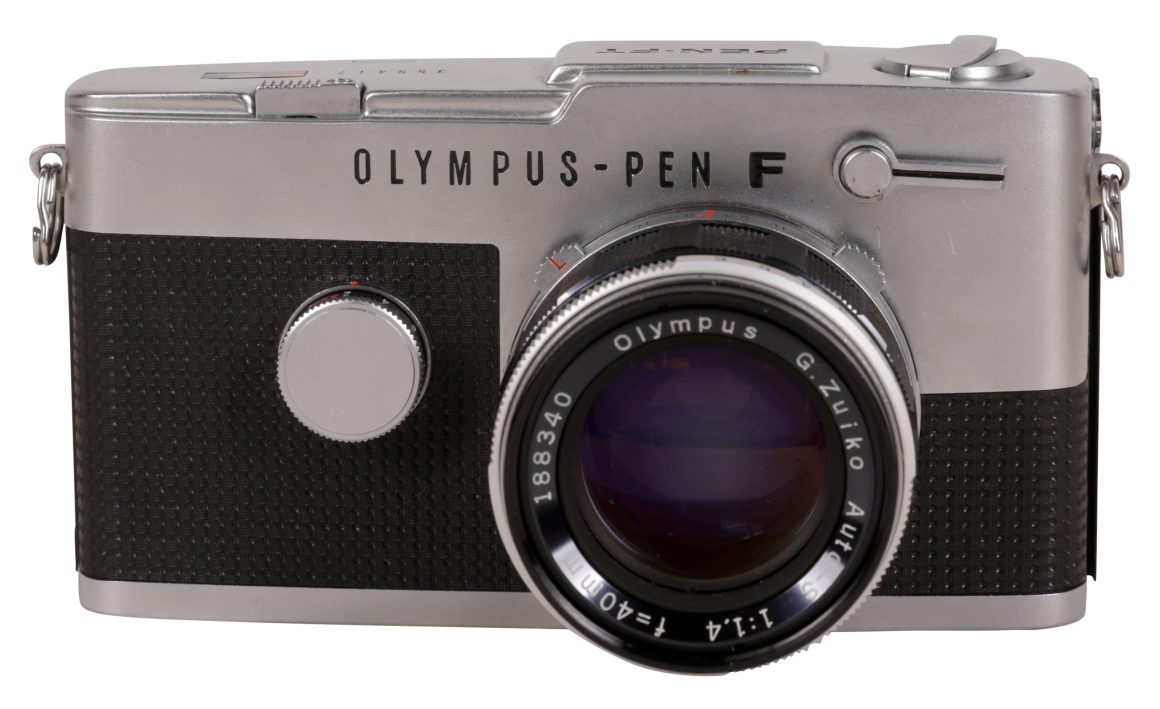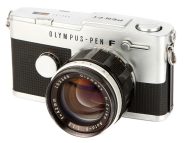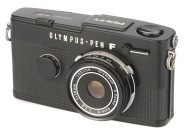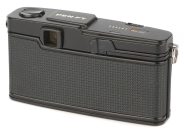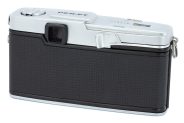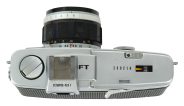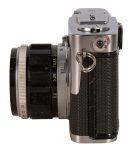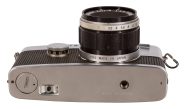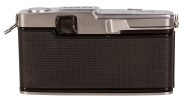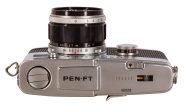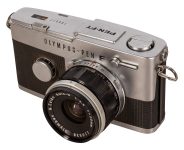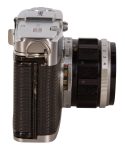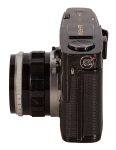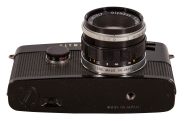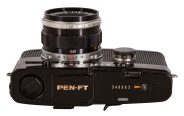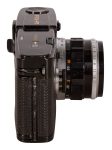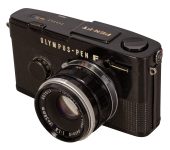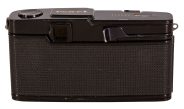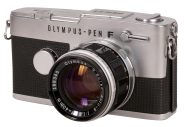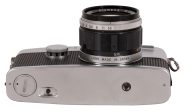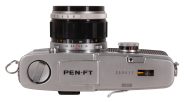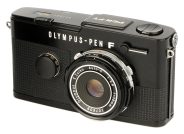Olympus Pen FT
Half frame MF film SLR camera
Specification
| Production details: | |
| Announced: | October 1966 |
| System: | ● Olympus Pen F (1963) |
| Format: | |
| Maximum format: | Half frame |
| Film type: | 135 cartridge-loaded film |
| Mount and Flange focal distance: | Olympus Pen F [28.95mm] |
| Shutter: | |
| Type: | Focal-plane |
| Model: | Mechanical |
| Speeds: | 1 - 1/500 + B |
| Exposure: | |
| Exposure metering: | Through-the-lens (TTL), open-aperture |
| Exposure modes: | Manual |
| Physical characteristics: | |
| Weight: | 600g |
| Dimensions: | 127x69.5x62.5mm |
Manufacturer description #1
The world-wide acceptance of the Olympus Pen F by both professionals and amateurs has not left the Olympus factory resting on its laurels. As part of its continuing program of Research and Development, a new improved model, the Pen FT, with a very advanced through-the-lens metering system is now available to the public.
Again Olympus has made improvements on existing single lens reflex technology without in any way compromising its commitment to compact size and minimum weight.
And because of the superior Olympus optics, negatives can be blown up to poster-size with excellent quality.
***
Olympus engineers were not content with the solutions arrived at by other manufacturers in the design of a through-the-Iens metering system. The new Olympus FT system has several advantages over the existing systems.
1) A unique aperture numbering system replaces the cenventienal and often inaccurate F/step system.
It is characteristic of through-the-lens metering system that expesure calculations are influenced by the position of the meter, the speed of the lens and the focal length of the lens. Especially when the film is exposed at the maximum aperture, the F/stops very often do not accurately reflect the proper exposure.
To eliminate this error, found in all other metering systems, Olympus has designed a numbering system, beginning with "0" and ending with "7" to replace the conventional F/stop method. This is equivalent to the "F" stop calibration favored by the most exacting professional photographers.
Using this system, the meter reads out the exact correct exposure as the light is measured through the lens, and eliminates the errors found in conventional CdS meter F/stop systems.
2) Light measurements can be made at both "wide-open aperture" and "stopped down aperture."
Measuring at "wide-open aperture" is, of course, the most convenient for the photographer. But occasionally as when extension rings or extension bellows are used, it is very helpful to use the "stopped down aperture" measurement. The Olympus aperture numbering system assures a perfect exposure in both cases.
3) Averaging light measurement system
The FT uses an extra-large CdS meter equipped with a special device to screen out extraneous light. The meter is placed near the viewfinder eyepiece in the porroprism, and averages the total amount of light reaching the film surface.
***
1. The world's most unique design in a single lens reflex
The world of photography was astonished at the first appearance of the unique Olympus Pen F. Here was a camera that was a true single lens reflex, yet had eliminated the bulky prism on top of the camera. Here was a camera that was as compact as a rangefinder camera and even smaller.
And above all, here was a camera that introduced new standards of precision and quality to the single lens reflex field.
2. Unique PORROPRISM finder system
Olympus completely changed the appearance of single lens reflex cameras. Instead of the bulky pentaprism sitting awkwardly on top of a single lens reflex camera, Olympus introduced the built-in porroprism. A horizontal rather than vertical revolving mirror is used in the camera. Automatic diaphragms are used in the interchangeable lenses, thus the view in the finder is always bright as the viewing is done at full aperture.
3. The smallest, lightest and most convenient single lens reflex camera
The Olympus Pen FT weighs only half as much as the conventional 35mm single lens reflex camera, and its size is even smaller than a rangefinder camera. The savings in weight and size are extended through a large range of accessories that are equally compact.
It permits the photographer to carry more lenses, more accessories, and yet less weight.
4. Extreme close-up photography possible without additional accessories
The Olympus Pen FT is the only camera which permits a close-up photograph to be taken as close as 14 inches. The camera is therefore very convenient for photocopying, close-up photography of persons, plants, flowers, insects, etc. The convenience of close-up photography without the use of extra accessories cannot be overemphasized.
5. Full synchronization at all shutter speeds
The unique Olympus rotary metal focal plane shutter now makes it possible to synchronize strobo lighting at all shutter speeds. There are also M and X contacts for synchronization with all types of flash equipment.
6. New type shutter developed exclusively for the Olympus FT
This new type shutter has been developed exclusively for the OLYMPUS Pen FT to make it a super small-size, super efficient camera. A high speed rotary shutter with a speed of 27 meters per second; completely different in style from all conventional focal plane shutters. This is an all metal shutter using a super thin 35/-1000mm titanium diaphragm. It is extremely resistant to change in temperature and humidity, and change with years, and has remarkable durability. The precision of the shutter speed is also high, and some of the characteristic defects of conventional focal plane shutters (image distortion when a moving object is photographed, etc.) do not exist.
7. Half-frame economy and convenience coupled with quality equal to full frame in other cameras
When Olympus first presented the half-frame size seven years ago there was some doubt that the half-frame could equal to the quality in large prints obtained with full frame 35mm cameras. But Olympus engineers based their confidence in half-frame on two significant factors: First, the half frame is closer to the basic 8 X 10 format and thus there is less cropping in half frame than full frame. Secondly, the Olympus lenses are designed with higher resolving power. The final proof of course came in the thousands of fine prints made by leading professional photographers throughout the world.
8. An amazing range of accessories
The Olympus Pen FT is part of one of the world's largest photographic camera systems. Because the lenses and accessories have been designed for the smaller half-frame format, there is considerable savings in size, weight and cost. But absolutely no compromise in quality.
Manufacturer description #2
FILM SIZE: 24x18 mm.
LENS: (with F1.2 standard lens) H Zuiko Auto S, F1.2, f=42 mm, (with F1.4 standard lens) G Zuiko Auto S, F1.4, f=40 mm, (with F1.8 standard lens) F Zuiko Auto S, F1.8, f=38 mm. All lenses have fully automatic diaphragm and are marked on Through-The-Lens numbers and F-numbers.
LENS REPLACEMENT: Bayonet system ("Pen" mount).
SHUTTER: OLYMPUS rotary metal focal-plane shutter; B. 1-1/500 sec. (equally calibrated) one-pivot non revolving shutter speed dial.
SYNCHRONIZING: All shutter speeds synchronization with M & X contacts point switch.
VIEWFINDER: Porroprism finder, magnification 0.8X (standard lens), with microprism and special Fresnel lens.
MIRROR: Horizontally opening shockless quick return mirror.
LOADING: EL (easy loading) system.
FILM ADVANCING: 1-stroke lever type with an advancing stroke angle of 150 degrees, self-cocking to prevent double advances and double exposures.
FILM COUNTER: Exposed counting, self-resetting type.
FILM REWINDING: Crank type rewind button setting system.
FOCUS ADJUSTMENT: Direct advancing helicoid system, minimum close-up distance 35cm.
EXPOSURE ADJUSTMENT: Through-The-Lens number system, both open and stopped-down aperture methods available.
LIGHT MEASURING RANGE: EV3~EV17 (ASA 100) with F1.4 standard lens.
LIGHT ACCEPTOR: Extra-large CdS meter, average light measurement method.
POWER SOURCE: Mercury battery (1.3 volts).
FILM SPEED RATING SCALE: ASA 25-400.
SELF-TIMER: Lever system (90 degrees) actuated in about 11 seconds.
REAR COVER OPERATION: "Magic" locking hinge system.
Manufacturer description #3
Introducing the new Olympus PEN FT Pro f2.8. The PEN FT has long been a favorite of photographers who discovered that this little jewel of a camera could do anything a full frame 35mm SLR camera could do, and more. Part of the enchantment was with the extensive Olympus PEN FT system - an amazing assortment of lenses and accessories, all smaller, lighter and in many cases less in cost than for other SLR cameras. Other PEN FT fans fell in love with the Zuiko lenses, which are made in Olympus' own factory and rate with the world's finest and most expensive lenses. But the outstanding feature of the PEN FT is its small size. A photographer can literally put the basic elements of an SLR system into his shoe and have room left for film.
Now the new f2.8 Zuiko lens makes the PEN FT even smaller, in fact small enough to fit into your shirt pocket. This specially designed 38mm, f2.8 Zuiko lens just barely protrudes from the camera body and compares in resolution and contrast to the best of the famous Zuiko lenses.
From the Modern Photography magazine (1970)
The superbly performing, small and convenient Olympus Pen FT, world's only half-frame single-lens reflex, now has an all-black companion model, the Olympus Pen FT PRO. Aside from the color, both cameras have identical specifications, except that the PRO is fitted with a superflat 38mm f/2.8 Zuiko lens which extends barely 1/2-in. from the camera body also making it the world's only pocketable SLR. Another advantage of the Pen's 18 x 24mm format is the very compact 50-100mm f/3.5 Zuiko zoom which fills the frame like a 70-130mm zoom on a full-frame camera.
The Pen FT engineers have incorporated a large-area CdS printed circuit meter behind one of the reflecting surfaces in the finder. The meter integrates all the light from the entire finder area. The Olympus meter pointer number scale is visible through the finder at the left of the picture area.
First you set the ASA of the film (25 to 400) in a small window on the side of the shutter speed dial. Now set your shutter speed. Look through the finder to make your meter reading. The meter scale reads in Olympus meter numbers from 0 to 7. Note the number on which the pointer rests (or point between numbers) and set this number on the aperture ring.
These numbers on the top of the aperture ring are not f/stops. If you wish to find out what f/stop the number represents you can turn the camera upside down and look at the diaphragm ring markings on the bottom.
If you'd rather make a meter reading at shooting aperture, you can do it. Just press the preview button on the lens mount and turn the diaphragm ring until the pointer inside the finder lines up with the lowest number on the lens you're using. Now you're ready to shoot.
Be not in anguish if you have any older Olympus Pen F lenses without meter numerals. You will be able to purchase adhesive numeral strips to cover your diaphragm ring.
The FT meter read within 1/2 f/stop of a known light source over its entire range. The meter can read down to f/2 at 1/15 sec. with an ASA 400 film. It is also possible to use the meter with non-Olympus manual or preset lenses.
The new microprism snaps the image in and out of focus efficiently, although the meter system has caused an overall viewing light loss of approximately 2 f/stops. However, by eliminating the outer Fresnel rings, the entire screen has been made usable for focusing.
Other Pen FT and PRO features: a single-stroke, long-armed wind lever, self-timer, quick-loading multiple slot and tooth type take-up spool.
From the editor
The weight and dimensions are indicated for the camera body with the F1.8 standard lens.
